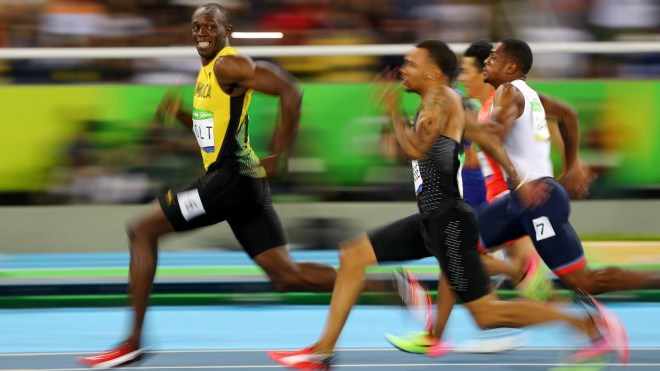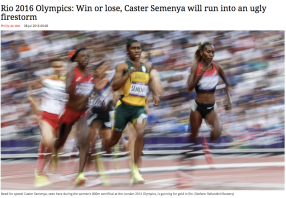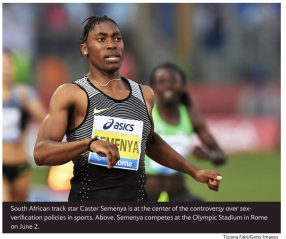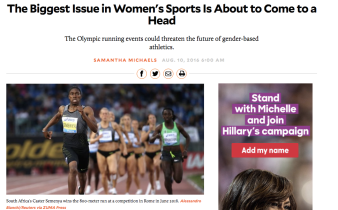Originally posted by J. Doyle at The sports Spetacle on 16/08/2016. Available at: https://thesportspectacle.com/2016/08/16/capturing-semenya/
August 16, 2016 by
As the women’s 800m approaches, headlines about Caster Semenya proliferate — once again, seven years after she won the World Championship in the 800m and became a news headline, we have been saturated with “debates” about her presence on the track. This year, these stories unfold in striking contrast with those celebrating other athletes who dominate their events. Where Usain Bolt’s singularities (at 6’5″ he is unusually tall for a sprinter) are presented as a blessing, hers are presented as a curse. In the past week, feminist writers have pushed back on the bullying of Semenya by the press. (See, for example, Jules Boykoff’s interview with bio-ethicist Katrina Karkasis, Kate Fagan’s op-ed on the racism and sexism which pattern writing about Semenya.) The story of Semenya has been produced as the worst kind of clickbait and so, as exhausted as many of us are by seven years of making the same intervention over the same athlete, we cannot sit this news cycle out — we’ve been drawn, again, into the same fight.
This year, I notice that stories about Semenya tend to be illustrated by images in which she faces the camera. We see her broad shoulders, her braids, her serious face. Her speed puts her in the media’s view, but the preferred image of Semenya communicates not speed but strength. While the image of Usain Bolt’s lead is celebrated as already iconic, the image of Semenya’s physique circulates as a warning. It is used to present Semenya’s presence on the track as “unfair.”

Images of Semenya running, especially when those images are shot from the side of the track, illustrate her speed and also affirm her context: the women’s 800m. The dominant frontal framing of her image, however, excludes her competitors or leaves them out of focus — a visual tactic which affirms the “truth” of sexist/racist vision that cannot see her as a woman.

The media approaches Katie Ledecky’s superdominance in the pool with a giddy enthusiasm. Editors seem to enjoy illustrating the distance that Ledecky puts between herself and everyone else, and how Usain Bolt manages to come from behind in the world’s fastest sprint. Ledecky’s stamina is a miracle, Bolt’s stride expresses the blessing of his freakish height. The potential of Semenya’s speed on the track, however, has been narrated as a “ticking time bomb” and a threat “to the future of gender based athletics.” Over the image of Semenya’s broad shoulders Slate’s editors drape the question, “Should Semenya be allowed to compete against women?”
Behind that question is the long story of the attempt to create a “fair” gender test, given that gender differences are not reducible to any single aspect of a person’s being. Debate about gender testing has been staged almost exclusively around Semenya since she first came onto the world’s stage in 2009.
This attention to Semenya and the IAAF’s (the recently suspended) use of testosterone levels to police women athletes has distracted people from the myriad of other rules which enforce gender segregation.
To ask if Semenya should be allowed to run against women, for example, suggests that Semenya has some other option. Even if a woman runner wanted to compete against men, even if such competitions were allowed (they aren’t), that athlete’s performances against men would not qualify her for events like the Olympics even if she ran faster than all the men in the world. Not only would such a thing not “count” as a women’s world record, it would not qualify her for the Olympics in any gender category. Women are not only not allowed to run against men, in some ways, they are not allowed to run with them.
IAAF regulations regarding qualification for the Olympics are quite clear on this:
Performances achieved in mixed competitions in track events will not be accepted. Exceptionally, in accordance with IAAF Rule 147, performances achieved in events of 5000m and 10,000m may be accepted in circumstances where there were insufficient athletes of one or both genders competing to justify the conduct of separate races and there was no pacing or assistance given by an athlete(s) of one gender to an athlete(s) of the other gender. [IAAF Rio Qualification and Systems Standards]
The prohibition of cross-gender pacing was produced to address the fact that men and women often run alongside each other in longer distances, especially the marathon. A few years back, disturbed by the spectacle of this athletic miscegenation (in sports, men and women are treated as a different species in a manner that closely resembles white supremacist and eugenic discourse about racial difference), IAAF officials decided to distinguish world records set by women in women-only races from records set by women running in “mixed” races (where the fastest women are running with, and being paced by men). Records set by women in “mixed” races should not, according to the IAAF, be understood as women’s records. The IAAF treats pacing — the situation of every runner who is not the fastest on the track — as a form of unfairness only when the men and women are on the track together. And so mixed races cannot be used to qualify for the Olympics.
There is no good reason for this rule.
Women are prohibited from being paced by men because the fastest men make the fastest women faster. Top women athletes in a range of sports — from running to soccer to judo — train alongside and against men. So, why can’t women run with them? Why don’t women’s achievements in competitions that include men count as a women’s achievements? If mixed-gender pacing is so wrong, why allow it in training?
The spectacle of mixed gender racing unravels fascistic models of sex/gender difference and sex/gender purity. Every woman runner competes with the lie that men are faster than women. That fiction can only be maintained by ensuring that men and women never run with each other — when men and women run with each other, they scale down each other’s understanding of their differences.
The truth is: the fastest men are faster than the fastest women. Some men are faster than all women and most men, but some women are also faster than most men. Most men reading these sentences, for example, are quite a bit slower than Caster Semenya — most men reading these sentences are, in fact, quite a bit slower than the slowest women running her event in Rio.
[For example: Mary Keitany finished the 2015 NYC Marathon in 2:24:25. This time was the 19th fastest overall that year, and about fourteen minutes behind Stanley Biwot’s winning performance. She finished, in other words, 19th in a field of nearly 50,000 people. She ran the marathon faster than all the women and faster than about 28,880 men. Keitany started the race 30 minutes before the men: her time would likely have been faster had she been running with the professional men. Marathon starts are staggered: people are lined up according to their pace. It is only at the “professional” level that men and women are segregated from each other.A fun fact, in 2015, a slightly higher percentage of women completed the NYC marathon than men.]
Protecting Women from Each Other
The IAAF presents its prohibition against cross-gender pacing as a defense of the integrity of women’s running events. The suppression of the fastest women’s capacity for speed by the prohibition of cross-gender pacing in long distance running is not, however, in women’s interest.
Arguments for Semenya’s exile from sports are not unlike that stupid rule. As sporting bodies confront the fact (and this is a fact!) that there is not one isolatable element which “causes” men to the men and women to be women, they are losing their ability to police the difference between men and women. That policing is now clearly visible as unethical: it is categorically unfair by every measure of sporting fairness.
Bioethicist Karkazis explains:
So-called sex testing policies have been around for decades and are aimed at controlling sex and policing who can legitimately compete as a woman. All of the policies, which rely on an individual criterion—for example, chromosomes—to determine women’s eligibility, have been based on the faulty assumption that any singular marker of sex is adequate to classify people as male or female. Because no one sex marker is definitive, the policies have always unfairly excluded some women.
Sports governing bodies have said they abandoned sex testing in the 1990s. But they clung to a reserve clause allowing them to investigate any woman they deem “suspicious.” They investigated Caster Semenya [in 2009] during the period the policies were “abandoned.”
Despite the scientific-sounding rationale about competitive advantage, only the screening criterion has changed; it’s now testosterone levels. Unlike chromosomes,T levels can be manipulated, and so for the first time women are required—effectively coerced—to change their bodies to maintain eligibility, consequently “violat[ing] ethical standards of clinical practice and constitut[ing] a biomedical violence.” Policymakers nevertheless characterize the regulation as “progressive.”
Note that no other extraordinary athlete has been singled out with such determination for this form of exile or medical intervention — not Michael Phelps, not Katie Ledecky, not Usain Bolt, and not Simone Biles. Each of these Olympians is arguable more dominant in their sports that Semenya is in hers; Phelps and Bolt, furthermore, have maintained their dominance over a long stretch of time.
The US women’s national soccer team, which for decades has advanced to the semifinals or finals of every major international tournament (but not this one!), is not banned from international competition for the massive advantage the team enjoys by virtue of the fact that the USSF is not as sexist or as corrupt as Brazil, Spain, Chile or Mexico’s federations, which hobble their women’s teams. If journalists and pundits actually cared about “protecting” the integrity women’s sports they might investigate the intersection of corruption and sexism in sports. Sexism and corruption actually harm women’s sports. Gender variance enhances them.
Competitive sports are about difference. They produce differences in speed, distance and skill. Women are quite different from each other. Men are also quite different from each other. Usain Bolt’s physical difference from his competitors is actually very similar to Caster Semenya’s difference from hers (they both look stronger than everyone else). In sports, men’s physical differences from each other do not lead to their disqualification. Usain Bolt is so tall (6’5″) that he covers his distance in fewer steps than do his competitors. This is one of the many things that makes Bolt so fast. It does not make him so much of a man that he has an “unfair” advantage over other men. It makes him into a hero, not a monster.
Women athletes who perform above people’s expectations regarding women’s capacity — especially when they are black — are scrutinized not as athletes, but as women. Meaning: they are evaluated according to a racist and sexist sense of what defines women. Any aspect of her being which defies that image, which is in conflict with cultural notions about what makes a woman a woman is at risk of being identified as having “unfair” advantage — she is, in this view, a threat to other women.
As Kate Fagan argues, in conversation about the rules maintaining sex segregation in sports, where those conversations are not informed by expertise regarding sex/gender differences, women’s sports has increasingly been presented as a “protected category.” This has, she points out, gotten worse as sports federations have been forced to confront the bad intentions (and bad science) behind any number of gender tests. Fagan writes:
This “conversation” is supposedly about fairness and protection. Or, rather, protecting female athletes whose appearance reflects society’s standard of femininity. Ross Tucker, a South African professor of exercise physiology who has banged the drum the loudest (and who did not respond to multiple email requests for an interview), offered this quote to the Guardian: “If Semenya can eventually run 1:51 she is better than [Usain] Bolt comparatively. But Bolt doesn’t compete in a protected category for people with fast-twitch muscle fibers. He isn’t subjected to the same classification issues as Semenya is by virtue of the fact we’re trying to protect women.”
Who are women being protected from in this instance, Fagan asks, if not each other?
Malcolm Gladwell and Nicholas Thompson indulge the same line of thinking in an awful conversation published recently in The New Yorker. Gladwell explains to Thompson,
no one is saying that Caster Semenya shouldn’t be able to compete. People are only saying that women’s athletics—as a “protected category”—requires her to have testosterone levels in line with her competitors’.
The two non-experts express their agreement with what “people are saying” and proceed to dress up their sexism with technical-sounding bullshit about testosterone, hyperandrogenism and gender difference. They discourse about these issues as if it were self-evident that all women athletes should have testosterone “in line with her competitors” even though (for example) no such requirement is made of men. Gladwell and Thompson stage this conversation without any meaningful discussion of the decision issued by the International Court for Arbitration in Sports, which supported Indian athlete Dutee Chand’s challenge to IAAF/IOC rules which would require women with high T-levels to take hormone suppressants or face a lifetime ban.
Runner’s World published a terrific breakdown of CAS’s decision:
What did the CAS decide?
First, the court decided that the Hyperandrogenism Regulations are clearly discriminatory, in violation of the IAAF and IOC charters, because they apply only to women. There is no equivalent rule disqualifying high-T men from competition. Second, both Chand and the IAAF agreed that there should be a distinct female category of competition, and such competition should be “fair.” Third, the Hyperandrogenism Regulations are unlike other athletic bans in that they are essentially a lifetime ban, not a time-limited ban. Fourth, Chand failed to prove that a high-T woman taking estrogen and other female hormones would suffer a significant decline in performance.
Fifth and most important, the IAAF failed to establish that a woman born with naturally high testosterone levels has a significant performance advantage over other women
Unfettered by the weight of the science on this issue, uninterested in the rationale behind the decisions of the juridical bodies that determine what constitutes fairness in sports, Gladwell and Thompson borrow from the arbitrary nature of sports structures to explain why Semenya should not be allowed to compete. In an extraordinary bit of group masturbation, Gladwell and Thompson cite some more men to make Semenya’s exclusion appear as if it were necessary to maintain the structure of athletics. Again, Gladwell:
People need to understand that an athletic competition has to have rules; otherwise there can be no competition. David Epstein wrote a characteristically brilliant piece for Scientific American last week in which he quoted the philosopher Bernard Suits, who once described sports as “the voluntary acceptance of unnecessary obstacles.” And that’s what’s at issue here. Semenya is equipped with an extraordinary and anomalous genetic advantage. The previous policy of international track was that she could compete as a woman if she took medication to lower her testosterone to “normal” levels. That restriction has now been lifted. And so we have a situation where one woman, born with the biological equivalent of a turbocharger, is now being allowed to “compete” against the ninety-nine per cent of women who have no such advantage.
At about this point Gladwell cites Ross Tucker (the man Fagan cites as beating the testosterone drum the loudest), who explains,
We have a separate category for women because without it, no women would even make the Olympic Games (with the exception of equestrian). Most of the women’s world records, even doped, lie outside the top 5000 times run by men. Radcliffe’s marathon WR, for instance, is beaten by between 250 and 300 men per year. Without a women’s category, elite sport would be exclusively male.
Gladwell glides from the arbitrary nature of sports (“the voluntary acceptance of unnecessary obstacles”) to the subject of the difference between men and women in order to naturalize the expulsion of women from the category of women’s sports. This suggests, for example, that the contrived structure of track and field (why race 800 and not 850 meters?) — and an athlete’s “voluntary agreement” to compete within such a structure is akin to, say, one’s participation in sports as a man or a woman. This is, on its face, a stupid comparison.
(There is more nuttiness to the Tucker passage Gladwell cites: Why, in this imaginary world in which there is no “category for women,” would it be only the odd woman riding a horse who might qualify for the Olympics!? Why not archery? Or synchronized swimming? Or rhythmic gymnastics? Or wrestling? What about Ledecky, whose 1500m freestyle is already in the zone of men’s times? It’s quackery!)
This end-of-women’s-sports fantasy imposes on women’s sports a surprising fragility given that almost every women’s sport we can think of has survived being actively suppressed by men with arbitrary regulations and outright bans (limiting, for example, women’s tennis matches to three sets instead of five; barring women from marathons, virtually outlawing women’s soccer).
Women’s sports will not disappear because women with different hormone levels are allowed to compete against each other. PERIOD.
Women’s sports is not a “protected category.” It is, instead, the category that takes the most beatings.
Athletes compete as women by virtue of the alignment of their identity (as they perceive it, as others perceive it) with this already-existing category of gender. That alignment is not stable; it is a site of constant negotiation. And it is compulsory. We do not have women’s sports because women need to be protected from men. We have women sports because the world has women athletes. We also have women’s sports because gender difference is such a powerful, defining aspect of our experience of being in a body that we enjoy – as athletes and as spectators — the spectacle of gendered subjects in competition with each other as gendered subjects. Quite a few of us, furthermore, also enjoy direct physical competition across gender and know to our bones that women must be allowed to lose to men in order to win against them. And so when it comes to mixed-gender competition, there are a lot of us out here who say: bring it.
As IAAF regulations stigmatizing the speed of women racing against men show us, protecting women from direct physical competition against men holds women back. (Lindsey Vonn, the downhill skier, has bumped up against even more intense rules whose explicit aim is to slow women down. Men’s and women’s courses are mapped out differently, women’s courses are designed to be slower. When Vonn petitioned to race against men, she was petitioning to be allowed to race the same course as men — in order to achieve faster times. That petition was denied.)
The only thing worse than these rules — which do nothing other than slow women down — is the attempt to root out from women all traces of their own masculinity — the shaming and humiliation of women on this score has got to stop.
Women’s sports is not a defensive structure from which men are excluded so that women might flourish. It is, in fact, the opposite of this: it is, potentially, a radically inclusive space which has the capacity to destroy the public’s ideas about gender and gender difference precisely because gender is always in play in women’s sports in ways that it is not in men’s sports (with a few exceptions — e.g. figure skating). Because men have been so committed to the “end of women’s sports” for so long, women’s sports thrives in the zone of destruction. It has its own character thanks to the gender trouble at its origin. If women’s sports has one job that really is different from men’s sports, it is the destruction of sex/gender difference. Men’s sports (with a few exceptions which prove the rule) reinforce ideologies of gender difference. Women’s sports destroy them.
We must take notice of that fact that for seven years the conversation about the relationship between gender difference and women’s sports has been staged exclusively around the body of Caster Semenya, even though there are other women athletes who are more dominant in their sports than Semenya and even though there are other very problematic gender-based rules in sports. Pundits choose Semenya’s story over these other subjects. Her broad shoulders, her hairstyle, her manner of dress, her sexuality — the queer, black female masculinity which she presents — allows these pundits the cheap thrill of unveiling a queer interloper. Malcolm Gladwell and Nicholas Thompson refer to her body with an invasive clinical language that masks their ignorance about it. This casual discussion of physical difference is an appalling rhetorical echo of the sexual violence of lynching campaigns (which were often staged in the name of protecting white womanhood). It resonates, too, with the murderous violence directed at gender non-conforming people the world over.
I have not seen anything like this sustained level of aggression in reporting on Katie Ledecky, whose dominance in her sport is much more spectacular than Semenya’s. Where Ledecky is subject to hushed speculation (“is she like Semenya?”), the media approaches Semenya as if she were a walking scandal. What makes one athlete’s superdominance appear like victory, and another like theft — what makes people agree on the need to protect one kind of athlete from another, if not the queerness of her blackness?
The Sex of Speed
We do not think of a race as a particularly gendered event. A race has an absolute clarity. This is its defining element: the spectator thrills in the event’s clarity, its definition. Someone wins, everyone else loses. The win and the loss are decisive.
This is quite different from obviously gendered sports like gymnastics and figure skating — in which the performance of gender is built into categories of judgment. These events are scored by a panel of experts. They are judged, and the moment of judgment is a part of these sports’ theatrics. The subjective nature of the way those athletes are judged is a part of that sport’s drama. The theater of these sports is not about things that are measurable (speed, distance, strength), but rather an unattainable perfection. The “perfect ten” must be elusive: once achieved it risks becoming not perfection but, instead, a standard. And so when perfect scores started to populate its scoreboards, the standards of measurement in gymnastics were changed. (This is the subject of Dvora Meyers’ The End of the Perfect 10.) The sport plays with a sense of flawlessness — a flawlessness which one can approach but never actually achieve.
Katie Ledecky and Caster Semenya’s performances are not about flawlessness. They are, instead, about the capacity for speed, pure and simple. Are they the fastest? Are they faster that all those who have ever raced? The answer to the former is yes, but the answer to the latter is no. One is taught to think that they are not the fastest ever because are they are women. What if we saw this difference differently? All men who are not Usain Bolt are slower than Usain Bolt; this is not because Usain Bolt is more of a man than they are. It is, quite simply, because he is faster.
Of course gender matters — we enjoy watching women compete. It is important enough for us to have fought quite hard, in fact, for the right to watch women compete against each other.
Women athletes who compete in sports which appear to be about absolutes, which promise the spectator a decisive result surface the fictive elements of their sport’s certainties and guarantees — what does it mean to be the fastest woman, but not the fastest person? What is a woman? Is that what prevents her from being faster? How do we know what that thing holding her back is?
Caster Semenya’s speed is mute reply to that question. Women who are the fastest and strongest stir up the matter around them. They open up new spaces of differences when they stretch their lead over the field. That space is gendered — and yes, the boundaries which define that space are porous. A handful of athletes in a lifetime slip through that gendered net. Whether that moment is figured by sports officials and the press as a kind of transcendence or as crime for which she must be punished has everything to do with the color of the athlete’s skin.
If Caster Semenya has the capacity to defy people’s sense of how fast a woman can run, let us hope she does that and more. Let us hope she sets one world record after another, and that these records stand for a hundred years as a cosmic payback for the shit she’s been through, the shit every woman has been through— cis, trans, black, brown, poor, gay, promiscuous, pregnant, abortive, sick, over-worked, underpaid and pissed-off.
Let her leave her sisters in the dust and laugh her way across the finish line.






